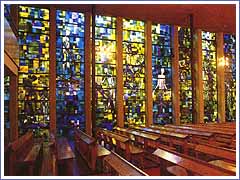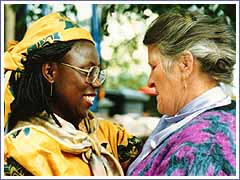Protestants in Austria
 There are two different Protestant Churches in Austria. One belongs to the Lutheran tradition and is called Protestant Church A.B. (= Augsburg Confession), the other one is part of the Reformed Tradition and is marked by the label H.B. (= Helvetic i.e. Swiss Confession). By signing the Deed of Tolerance Emperor Joseph II. brought about toleration of the Protestants, thereby ending their underground existence which had lasted for several decades. At the same time he characterized the two protestant bodies by attaching to them their particular confessional writings. Ever since the labels A.B. (Luteran) and H.B. (Reformed) have been in use to differentiate the two churches.
There are two different Protestant Churches in Austria. One belongs to the Lutheran tradition and is called Protestant Church A.B. (= Augsburg Confession), the other one is part of the Reformed Tradition and is marked by the label H.B. (= Helvetic i.e. Swiss Confession). By signing the Deed of Tolerance Emperor Joseph II. brought about toleration of the Protestants, thereby ending their underground existence which had lasted for several decades. At the same time he characterized the two protestant bodies by attaching to them their particular confessional writings. Ever since the labels A.B. (Luteran) and H.B. (Reformed) have been in use to differentiate the two churches.
The combined membership of the Protestants in Austria (Lutheran Church 265.000, Reformed Church 12.000) make up close to 3 % of the total Austrian population of more than 8 million people. The Lutheran Church (A.B.) is structured into seven dioceses with a Superintendent at the top of each. The number of parishes totals to 200. The highest percentage of Protestants is to be found in the region of Burgenland (10,5 %). Strong protestant presence can also be found in Carinthia and Upper Austria. Close to 47.000 Protestants live in Upper Austria – the highest concentration of Protestants in one particular area. Nine parishes belong to the Reformed Church (H.B.).
Both churches have a rather similar structure. Each has a synode as the highest governing body with a small executive committee (Oberkirchenrat A.B. and Oberkirchenrat H.B.). The highest ecclesiastical representative of the Lutherans is the bishop. For the Reformed Church the Landessuperintendent (Superintendent for all of Austria) holds that position. Both churches operate within a presbyteral-synodal constitution (i.e. on the level of parishes through presbyteries, on the level of the total church through synods; balance of laymen and clergy, democratic election process).
 The two churches do not act on the basis of a confessional or administrative union. Yet they work closely together in many areas. In order to „safeguard issues of common interest“ (Constitution § 5(3)) they instituted the „Protestant Church A.B. and H.B.“, a body made up of both churches. A „General Synode“ serves as „parliamentary“ instrument of this structure, assisted by the Evangelischer Oberkirchenrat A.B. und H.B. as executive committees.
The two churches do not act on the basis of a confessional or administrative union. Yet they work closely together in many areas. In order to „safeguard issues of common interest“ (Constitution § 5(3)) they instituted the „Protestant Church A.B. and H.B.“, a body made up of both churches. A „General Synode“ serves as „parliamentary“ instrument of this structure, assisted by the Evangelischer Oberkirchenrat A.B. und H.B. as executive committees.
Long before the socalled „Leuenberger Konkordie“ of 1973 was agreed upon (mutual recognition of ministers and Holy Communion, doctrinal differences no longer considered as seperating churches from each other). Lutheran and Reformed Christians in Austria worked together in areas of spritual as well as of administrative concerns. One of the spiritual backgrounds for this is the fact, that both confessions have Lutheran as well as Reformed members. The constitution is based on principles integrated within the confessions of both churches (so-called „confessing churchlaw“). Clergy and laity work together enjoying equal rights. All persons forming one congregation decide on matters relevant to their parish in a direct democratic process or through representatives elected from among them. They elect their minister and persons for other positions of responsibility. In matters pertaining to their parish they are autonomous.
This structure from the base upwards is continued on other levels of the Protestant Churches. Members of the synodal Executive Committees, as well as the Bishop A.B. (for 12 years, reelection allowed) and the Landessuperintendent H.B. (for 6 years, reelection allowed) are elected by the respective synods, made up by an equal number of clergy and laity. There is no „cumpulsory voting of lobbygroups“. Every person in a responsible position within the church is solely bound by his/her conscience (Constitution § 24).

